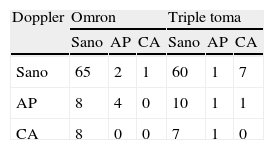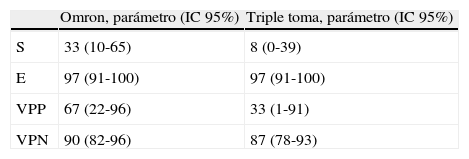Determinar la concordancia del índice tobillo-brazo (ITB) determinado mediante esfigmógrafo automático Omron y la medición automatizada mediante triple toma respecto al método de referencia doppler, así como su sensibilidad y especificidad.
Pacientes y métodosPacientes de la cohorte poblacional ARTPER, clasificados como arteriopatía periférica (AP) si ITB<0,9, calcificados si ITB≥1,4, y sanos. Se calculó el índice kappa para ver la concordancia entre los 3 métodos con estas categorías y el coeficiente de correlación intraclase (CCI) para ver la concordancia del valor continuo de ITB.
ResultadosSe incluyeron 88 participantes, un 52% mujeres, con una edad comprendida entre 57 y 87 años. Fue posible calcular el ITB en el 100% con doppler, en el 97% con Omron y en el 95% con triple toma. Las medias (desviación estándar) de ITB con los 3 métodos fueron: doppler 1,089 (0,236), Omron 1,082 (0,110), triple toma 1,146 (0,134), con pobre concordancia (CCI doppler/Omron=0,27, doppler/triple toma=0,13 y triple toma/Omron=0,39). Categorizando el ITB en AP-sano-calcificación presentaron ITB<0,9 un 13,6% (mediante doppler), 6,8% (Omron) y 3,4% (triple toma), e ITB≥1,4 un 9,1% (mediante doppler), 1,1% (Omron) y 9,1% (triple toma), obteniendo índices kappa débiles (doppler/Omron=0,22, doppler/triple toma=0,01, triple toma/Omron=0,17). Tanto Omron como triple toma fueron muy específicos (97%), pero muy poco sensibles (8 y 33%, respectivamente) con respecto a doppler.
ConclusionesNi Omron ni triple toma tienen una buena concordancia con doppler, por lo que los primeros no parecen adecuados para el cribado de AP en las consultas de atención primaria.
To determine the concordance of the ankle-brachial index (ABI) determined by automatic measurements (sphygmomanometer Omron and the triple cuff device) using doppler as the gold-standard, computing as well as sensitivity and specificity.
Patients and methodsARTPER population cohort subjects, classified as peripheral arterial disease (PAD) if ABI<0.9, calcified if ABI≥1.4 and healthy otherwise. To asses concordance we used kappa index using the 3 categories and the intraclass correlation coefficient (ICC) for ABI continuous values.
ResultsEighty-eight participants, 52% women, 57-87 years. It was possible to calculate the ABI using doppler for 100%, 97% using Omron and 95% using triple. ABI means (standard deviation) were: doppler 1.089 (0.236), Omron 1.082 (0.110), triple 1.146 (0.134), with poor agreement (ICC doppler/Omron=0.27, doppler/triple=0.13, and triple/Omron=0.39). Categorizing ABI as PAD-healthy-calcified 13.6% (doppler), 6.8% (Omron) and 3.4% (triple) were PAD and 9.1% (doppler), 1.1% (Omron) and 9.1% (triple) were calcified. Kappa indexes were weak (doppler/Omron=0.22, doppler/triple=0.01, triple/Omron=0.17). Both triple and Omron were highly specific (97%) but had very low sensitivity (8 and 33%, respectively) compared to doppler.
ConclusionsConcordance of ABI automatic measurements as Omron and triple with doppler was poor, and they do not seem suitable for screening for PAD in primary care consultations.
Artículo
Comprando el artículo el PDF del mismo podrá ser descargado
Precio 19,34 €
Comprar ahora














